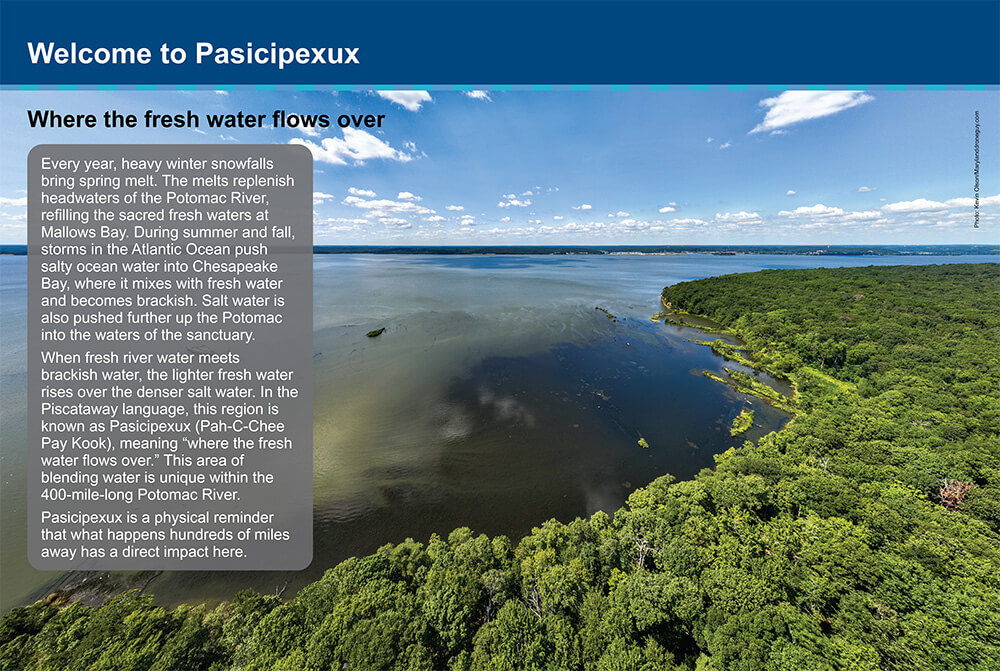Welcome to Pasicipexux – Where the fresh water flows over

Every year, heavy winter snowfalls bring spring melt. The melts replenish headwaters of the Potomac River, refilling the sacred fresh waters at Mallows Bay. During summer and fall, storms in the Atlantic Ocean push salty ocean water into Chesapeake Bay, where it mixes with fresh water and becomes brackish. Salt water is also pushed further up the Potomac into the waters of the sanctuary.
When fresh river water meets brackish water, the lighter fresh water rises over the denser salt water. In the Piscataway language, this region is known as Pasicipexux (Pah-C-Chee Pay Kook), meaning “where the fresh water flows over.” This area of blending water is unique within the 400-mile-long Potomac River.
Pasicipexux is a physical reminder that what happens hundreds of miles away has a direct impact here.
Photo: Kevin Olson/Marylanddroneguy.com
A Further Piscataway Perspective
We the Piscataway People speak for and honor the waters as the life-blood of our Earth Mother and an integral part of our spirituality. For centuries we have been taught by our ancestors to view the rivers and waterways as the arteries and veins of the Earth Mother. This is visually validated in the tides that pump the waters back and forth throughout her body. To our people the Potomac River is sacred. Water is sacred. We are taught to pray for our waterways, they are included in our ceremonies, and greatly respected. Our ancestors taught us to recognize the beauty and strength of these waters, and the need to preserve and protect them for future generations.
At this area on the Potomac River now designated as the Mallows Bay National Marine Sanctuary, we teach our next generation the lesson that “We are all Connected”. Every year, hundreds of miles away in the mountains to our west, heavy winter snowfall serves as the source of the spring snow melt. The snow melts into the headwaters of the Potomac River, then slowly replenishes the sacred fresh waters here at Mallows Bay. During the summer and fall months, Nor’easter storms and hurricanes in the Atlantic Ocean pushes salt ocean water into the Chesapeake Bay, where it mixes with freshwater and becomes brackish. Brackish water is pushed further up the Potomac River into the Mallows Bay National Marine Sanctuary.
When fresh river water meets brackish water, the lighter fresh water rises and moves over the denser salt water. In our Piscataway language we identify this area as Pasicipexux – (Pah-C-Chee Pay Kook) which means “Where the Freshwater Flows Over”. The Potomac River is about 400 miles long, but this area within the Mallows Bay - Potomac River National Marine Sanctuary is unique in that it is a part of the river where freshwater and brackish waters meet.
Our traditional knowledge explains why water is important to all that share life on this planet. By “all”, we mean plants, animals, fish, birds, and rocks. Water in our traditional communities is considered sacred medicine. If water can be viewed as sacred, then perhaps it will be taken care of and viewed in a different light than it is today by most people that live on our Earth Mother. This planet’s water is a sacred gift that much too often is taken for granted. Pasicipexux is a physical reminder that what happens 100s of miles away from this location has a direct impact here. We are taught to be thoughtful when making decisions, they may have an unexpected effect on others unknown to us. We are all Connected!
Story of Beaver
Mario Harley (Piscataway, Wild Turkey Clan) discusses the cultural significance of Beaver to the Piscataway People and its traditional role in the region’s ecology. Credit: National Marine Sanctuary Foundation, NOAA. Please contact the Piscataway Tribal Council to request authorization prior to using or reproducing this video.
Crawfish at Mallows Bay Park
Val Proctor (Piscataway), Stewardship Coordinator, Accokeek Foundation at Piscataway Park, discusses crawfish in Mallows Bay Park in Nanjemoy, Maryland. Credit: National Marine Sanctuary Foundation, Accokeek Foundation, NOAA.

